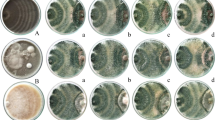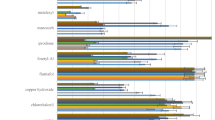Abstract
This study set out to assess the antagonistic activities of isolated marine and endophytic Trichoderma in controlling rice blast and brown spot diseases in a field trial. All selected Trichoderma strains were fast-growing and able to grow over the rice pathogens tested within 4 days in dual tests. Twelve marine and endophytic Trichoderma strains were evaluated for their antagonistic activities against rice blast and brown spot diseases under greenhouse conditions. Five strains that displayed significant biocontrol activities against both diseases were selected, and their antagonistic activities were assessed under field trials in rice var. KMDL 105 in both their fresh and dry formulations. The results showed that the fresh formulations of all Trichoderma exhibited higher disease control performance than did the dry ones. Among the Trichoderma tested, the application of a fresh formulation of endophytic T. harzianum KUFA0405 showed the most effective biocontrol activity in suppressing leaf and neck blast diseases by 57.19 and 60.35%, respectively, while its dry formulation resulted in lower activity against blast disease, resulting in 51.26 and 46.66% disease reduction on leaf and neck blast diseases, respectively. Not only did endophytic T. harzianum KUFA0405 show the best biocontrol activity against the disease, but it also resulted in increasing the rice yield to 226 and 218 kg/ Acre when applied in fresh and dry formulations, respectively, compared with the control treatment, which resulted in a rice yield of only 158 kg/ Acre. Meanwhile, the application of endophytic T. harzianum KUFA0406 showed the most effective biocontrol activity in suppressing brown spot disease, causing a 39.23% and 29.64% disease reduction when applied as fresh and dry formulations, respectively, and increasing the rice yield up to 257 and 244 kg/ Acre when applied in fresh and dry formulations, respectively, compared with the control treatment, which resulted in a rice yield of only 184 kg/ Acre.


Similar content being viewed by others
References
Abdel-Fattah, G. M., Shabana, Y. M., Ismail, A. E., & Rashad, Y. M. (2007). Trichoderma harzianum: A biocontrol agent against Bipolaris oryzae. Mycopathologia, 164(2), 81–89.
Agrios, G. (2005). Plant pathology (5th ed.). Elsevier Academic Press.
Asad, S. A. (2022). Mechanisms of action and biocontrol potential of Trichoderma against fungal plant diseases - a review. Ecological Complexity, 49, 100978.
Baite, M. S., Prabhukarthikeyan, S. R., & Raghu, S. (2022). Biological control of a fungus Ustilaginoidea virens causing false smut of rice. BioControl, 67(3), 357–363.
Baron, N. C., & Rigobelo, E. C. (2021). Endophytic fungi: A tool for plant growth promotion and sustainable agriculture. Mycology, 13(1), 39–55.
Chen, X., Jia, Y., & Wu, B. M. (2019). Evaluation of rice responses to the blast fungus Magnaporthe oryzae at different growth stages. Plant Disease, 103, 132–136.
Chou, C., Castilla, N., Hadi, B., Tanaka, T., Chiba, S., & Chiba, S. (2020). Rice blast management in Cambodian rice fields using Trichoderma harzianum and a resistant variety. Crop Protection, 135, 104864.
de Sousa, T.P., Chaibub, A.A., Cortes, M.V.C.B., Batista, T.F.C., Bezerra, G.A., da Silva, G.B., & de Filippi, M.C.C. (2021). Molecular identification of Trichoderma sp. isolates and biochemical characterization of antagonistic interaction against rice blast. Archives of Microbiology, 203(6), 3257–3268.
Dethoup, T., Kaewsalong, N., Songkumorn, P., & Jantasorn, A. (2018). Potential of a marine-derived species, Talaromyces tratensis KUFA 0091 against rice diseases. Biological Control, 119, 1–6.
Dethoup, T., Jantasorn, A., & Kaewsalong, N. (2022a). Efficacy of the antagonistic fungus Talaromyces tratensis KUFA0091 in controlling rice blast and brown leaf spot diseases in field trials. Agriculture and Natural Resources, 56(4), 697–704.
Dethoup, T., Klaram, R., Pankaew, T., & Jantasorn, A. (2022b). Impact of fungicides and plant extracts on biocontrol agents and side-effects of Trichoderma spp. on rice growth. European Journal of Plant Pathology, 164(4), 567–582.
Geddes-McAlister, J., Mau, Y. S., Prayetno, R. S., Kaka, H., Naat, K. D., Henuk, J. B. D., Hahuly, M. V., Widinugraheni, S., & Gandut, Y. R. Y. (2022). Efficacy of indigenous Trichoderma isolates of West Timor, Indonesia, as biocontrol agents of brown spot (Drechslera oryzae) on two upland rice varieties. Egyptian Journal of Biological Pest Control, 32(1), 62.
Guo, Q., Shi, L., Wang, X., Li, D., Yin, Z., Zhang, J., Ding, G., & Chen, L. (2023). Structures and biological activities of secondary metabolites from the Trichoderma genus (Covering 2018–2022). Journal of Agricultural and Food Chemistry, 71(37), 13612–13632.
Guo, R., Li, G., Zhang, Z., & Peng, X. (2022). Structures and biological activities of secondary metabolites from Trichoderma harzianum. Marine Drugs, 20(11), 701.
Jambhulkar, P. P., Sharma, P., Manokaran, R., Lakshman, D. K., Rokadia, P., & Jambhulkar, N. (2018). Assessing synergism of combined applications of Trichoderma harzianum and Pseudomonas fluorescens to control blast and bacterial leaf blight of rice. European Journal of Plant Pathology, 152(3), 747–757.
Jantasorn, A., Oiuphisittraiwat, T., Mongon, J., & Dethoup, T. (2023). In vivo testing of plant extracts in controlling rice brown spot disease through folia application. Indian Journal of Agricultural Research, 57(2), 242–248.
Kaewsalong, N., Songkumarn, P., Duangmal, K., & Dethoup, T. (2019). Synergistic effects of combinations of novel strains of Trichoderma species and Coscinium fenestratum extract in controlling rice dirty panicle. Journal of Plant Pathology, 101(2), 367–372.
Kalyabina, V. P., Esimbekova, E. N., Kopylova, K. V., & Kratasyuk, V. A. (2021). Pesticides: Formulants, distribution pathways and effects on human health – a review. Toxicology Reports, 8, 1179–1192.
Khan, R.A.A., Najeeb, S., Hussain, S., Xie, B., & Li, Y. (2020). Bioactive secondary metabolites from Trichoderma spp. against phytopathogenic fungi. Microorganisms, 8(6), 817.
Klaram, R., Jantasorn, A., & Dethoup, T. (2022). Efficacy of marine antagonist, Trichoderma spp. as halo-tolerant biofungicide in controlling rice diseases and yield improvement. Biological Control, 172, 104985.
Kokkrua, S., Ismail, S. I., Mazlan, N., & Dethoup, T. (2020). Efficacy of berberine in controlling foliar rice diseases. European Journal of Plant Pathology, 156(1), 147–158.
Kongcharoen, N., Kaewsalong, N., & Dethoup, T. (2020). Efficacy of fungicides in controlling rice blast and dirty panicle diseases in Thailand. Scientific Reports, 10(1), 16233.
Li, T., Xu, J., Gao, H., Cao, Z., Wang, J., Cai, Y., Duan, Y., & Zhou, M. (2022). The G143A/S substitution of mitochondrially encoded cytochrome b (Cytb) in Magnaporthe oryzae confers resistance to quinone outside inhibitors. Pest Management Science, 78(11), 4850–4858.
Limdolthamand, S., Songkumarn, P., Suwannarat, S., Jantasorn, A., & Dethoup, T. (2023). Biocontrol efficacy of endophytic Trichoderma spp. in fresh and dry powder formulations in controlling northern corn leaf blight in sweet corn. Biological Control, 181, 105217.
Liu, B., Stevens-Green, R., Johal, D., & Buchanan, R. (2022). Fungal pathogens of cereal crops: Proteomic insights into fungal pathogenesis, host defense, and resistance. Journal of Plant Physiology, 269, 153593.
Llones, C. A., Mankeb, P., Wongtragoon, U., & Suwanmaneepong, S. (2022). Production efficiency and the role of collective actions among irrigated rice farms in Northern Thailand. International Journal of Agricultural Sustainability, 20(6), 1047–1057.
Mohd Anuar, I. S., Ku Sulong, K. A., Abdul Ghani, H., & Wahab, M. Z. (2020). Alginate encapsulation of Trichoderma harzianum against brown spot disease on rice (Oryzae sativa) in vivo assays. Food Research, 4, 138–141.
Naeimi, S., Khosravi, V., Varga, A., Vágvölgyi, C., & Kredics, L. (2020). Screening of organic substrates for solid-state fermentation, viability and bioefficacy of Trichoderma harzianum as12-2, a biocontrol strain against rice sheath blight disease. Agronomy, 10(9), 1258.
Ng, L. C., Sariah, M., Sariam, O., Radziah, O., & Zainal Abidin, M. A. (2016). PGPM-induced defense-related enzymes in aerobic rice against rice leaf blast caused by Pyricularia oryzae. European Journal of Plant Pathology, 145(1), 167–175.
Pérez-Torres, E., Bernal-Cabrera, A., Milanés-Virelles, P., Sierra-Reyes, Y., Leiva-Mora, M., Marín-Guerra, S., & Monteagudo-Hernández, O. (2018). Efficiency of Trichoderma harzianum (Strain A-34) and its culture filtrates on control of three rice fungal aerial diseases. Bioagro, 30(1), 17–26.
Putri, N. D., Aini, L. Q., Muhibuddin, A., & Trianti, I. (2022). Screening of endophytic fungi as potential antagonistic agents of Pyricularia oryzae and evaluation of their ability in producing hydrolytic enzymes. Biodiversitas, 23(2), 1048–1057.
Rajeswari, E., Srinivas Prasad, M., Vidya Sagar, B., Madhav, M.S., Savani, A.K., Kannan, C., Maheshwari, T.U., Devi, G.U., & Ramanjineyulu, P. (2023). Unveiling the potential of rice rhizospheric microbes and indigenous organic sources for the management of rice blast. Journal of Phytopathology, 171(4–5), 165–179.
Ruan, H., Tian, P., Shi, N., Du, Y., Chen, F., & Chen, F. (2022). Characterization of pyraclostrobin-resistant Magnaporthe oryzae. Journal of Phytopathology, 170(4), 233–241.
Safari Motlagh, M.R., Jahangiri, B., Kulus, D., Tymoszuk, A., & Kaviani, B. (2022). Endophytic fungi as potential biocontrol agents against Rhizoctonia solani J.G. Kühn, the causal agent of rice sheath blight disease. Biology, 11(9), 1282.
Sharma, A., Gupta, B., Verma, S., Pal, J., Akanksha, M., & Chauhan, P. (2023). Unveiling the biocontrol potential of Trichoderma. European Journal of Plant Pathology, 167(4), 569–591.
Sirikamonsathien, T., Kenji, M., & Dethoup, T. (2023). Potential of endophytic Trichoderma in controlling Phytophthora leaf fall disease in rubber (Hevea brasiliensis). Biological Control, 179, 105175.
Sood, M., Kapoor, D., Kumar, V., Sheteiwy, M. S., Ramakrishnan, M., Marco Landi, M., Araniti, F., & Sharma, A. (2020). Trichoderma: The “secrets” of a multitalented biocontrol agent. Plants, 9(6), 1–25.
Vijitrpanth, A., Jantasorn, A., & Dethoup, T. (2023). Potential and fungicidal compatibility of antagonist endophytic Trichoderma spp. from rice leaves in controlling dirty panicle disease in intensive rice farming. BioControl, 68(1), 61–73.
Vinale, F., & Sivasithamparam, K. (2020). Beneficial effects of Trichoderma secondary metabolites on crops. Phytotherapy Research, 34(11), 2835–2842.
Widmer, T. L. (2019). Compatibility of Trichoderma asperellum isolates to selected soil fungicides. Crop Protection, 120, 91–96.
Yadav, A. N., Kour, D., Kaur, T., Devi, R., & Yadav, A. (2022). Endophytic fungal communities and their biotechnological implications for agro-environmental sustainability. Folia Microbiologica, 67(2), 203–232.
Yang, Y., Ye, R., Srisutham, M., Nontasri, T., Sritumboon, S., Maki, M., Yoshida, K., Oki, K., & Homma, K. (2022). Rice production in farmer fields in soil salinity classified areas in Khon Kaen, Northeast Thailand. Sustainability (Switzerland), 14(16), 9873.
Yao, X., Guo, H., Zhang, K., Zhao, M., Ruan, J., & Chen, J. (2023). Trichoderma and its role in biological control of plant fungal and nematode disease. Frontiers in Microbiology, 14, 1160551.
Zhu, H., Zhou, H., Ren, Z., & Liu, E. (2022). Control of Magnaporthe oryzae and rice growth promotion by Bacillus subtilis JN005. Journal of Plant Growth Regulation, 41(6), 2319–2327.
Acknowledgements
This work was financially supported by National Research Council of Thailand (NRCT), grant no. N41A640083.
Funding
National Research Council of Thailand (NRCT), N41A640083, Tida Dethoup
Author information
Authors and Affiliations
Corresponding author
Ethics declarations
Conflict of interest
The authors declare no conflict of interest.
Ethical approval
This article does not contain any studies with human participants or animals performed by any of the authors.
Informed consent
Informed consent was obtained from all individual participants included in the study.
Rights and permissions
Springer Nature or its licensor (e.g. a society or other partner) holds exclusive rights to this article under a publishing agreement with the author(s) or other rightsholder(s); author self-archiving of the accepted manuscript version of this article is solely governed by the terms of such publishing agreement and applicable law.
About this article
Cite this article
Seekham, N., Kaewsalong, N., Jantasorn, A. et al. Field biocontrol efficacy of Trichoderma spp. in fresh and dry formulations against rice blast and brown spot diseases and yield effect. Eur J Plant Pathol (2024). https://doi.org/10.1007/s10658-024-02854-9
Accepted:
Published:
DOI: https://doi.org/10.1007/s10658-024-02854-9




